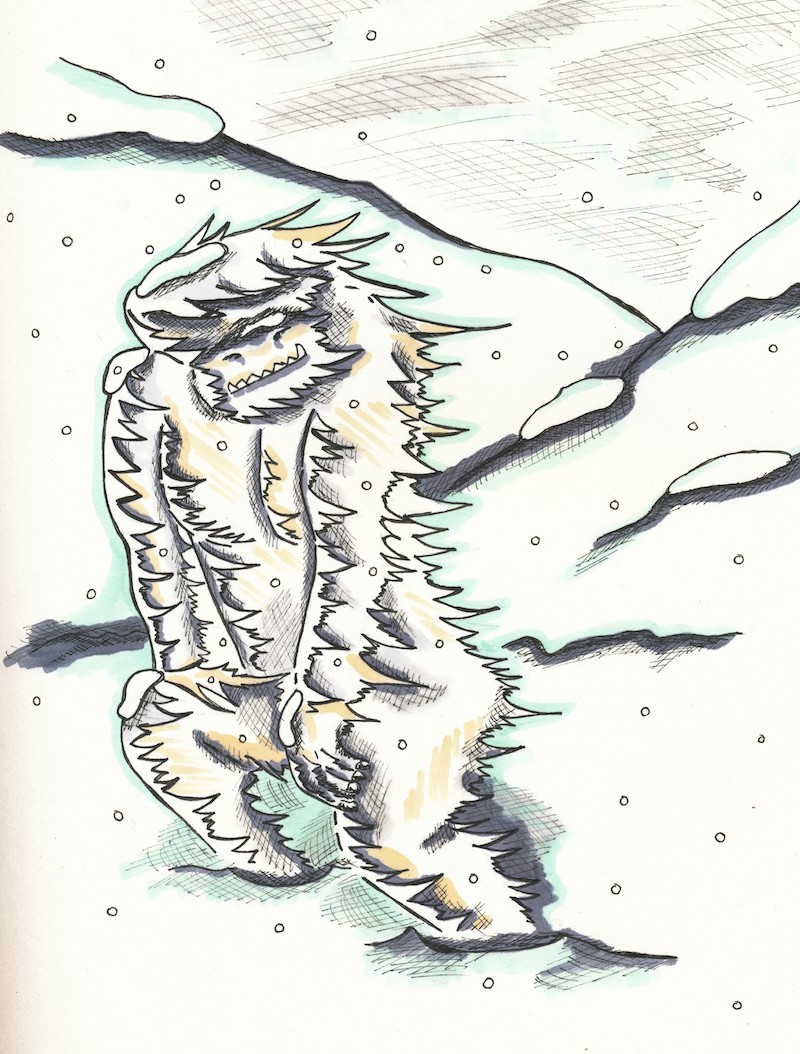Search Results for Tag: nepal
The Yeti
Just as Sasquatch/Bigfoot, the Yeti is described as an ape-like species walking on two legs. He is said to be living in the Himalayan regions of Nepal and Tibet. And also, the Yeti’s roots can be traced to ancient narratives. But unlike what we understand the Yeti to be today, the natives of the Himalayas did not talk about an Abominable Snowman with white fur, but of an angry dark-haired gorilla- or bear-like creature that lived high in the mountains. (described in “Abominable Science” p.75).
A lot of movies have cemented the snowman-picture, for example the first ever Yeti movie “The Snow Creature” from 1954. The Yeti even has a guest appearance in the highly successful “Monsters, Inc (2001)” and is the namesake of the official airline of Nepal, Yeti Airlines. But when did the Yeti, this creepy creature that used to strike terror into the hearts of the Himalayan people, become cool? The story is much older than that of the Sasquatch or Nessie. According to H. Siiger the Yeti has always been a part of the region’s mythology, people have dozens of names for it. The name we use today is most likely a mispronunciation of the Sherpa name for the man from the mountains: Yeh-teh = animal of rocky places. When the first expeditions entered the rocky region, the expedition participants took the story back home.
In 1832 the first descriptions were published in travellers’ journals, talking about tall, bipedal creatures covered with long dark hair. Later footprints were reported. Similar reports have repeatedly been published until today. In 1925, N. A. Tombazi, a member of the Royal Geographical Society, reported a sighting at about 4,600 m. And during an expedition of the British Newspaper Daily Mail in 1954 mountaineering leader John Angelo Jackson (pdf) photographed footprints many of which many were unidentifiable (and therefore of Yeti origin?). The mystery of the snowman grew. And went fully ‘viral” (to use a modern term) when an expedition found what they believed to be a Yeti scalp.
Climate champ – giving a voice to remote communities

Saurav Dhakal from Nepal
Do you feel responsible for our future? Are you tired of waiting for a breakthrough at climate conferences? If you are already taking action yourself, you are our ClimateChamp and we want to get to know you! Answer our questionaire to become a part of our new blog series, take your chance to be nominated as a Climate Champ.
What is your name? How old are you? And where do you live?
My name is Saurav Dhakal. I’m 33 years old. I live in Kathmandu, the capital of Nepal. But I frequently travel around the mountain communities of the country.
How does climate change affect your everyday life in your community?
We live in the mountains and so climate change affects us very closely. Right now I live in the capital city without electricity. But Nepal does have a plentiful water supply. People in the mountains generally don’t have much access to basic needs such as food, electricity, drinking water, healthcare or education. So it becomes very hard to adapt especially in the face of growing climate change.
What trigger event led you to start fighting climate change?
As a journalist, I’ve worked on different stories related to environment and climate. Gradually I realized that the stories related to these issues did not get much attention in the media. Then I started a new approach to make those issues prominent. Basically, I make stories accessible to the mainstream via my websitewww.storycycle.com
How exactly do you fight climate change?
“Story Cycle” helps storytellers from different communities to develop, produce and disseminate their own stories. These films allow people to explore different topics, including how the changing climate is impacting them and their families, how they are coping, and what they need to do in order to adapt. We listen and capture multimedia stories from the community and disseminate them to the world via our website (www.storycycle.com), our partners in mainstream media agencies and public showings. We also use other conventional ways such as multimedia magazines, MMS, and DVD clips for distribution to communities without Internet access. A story cycle is complete when stories flow from the source to the masses and then return to their origin. Recently, I visited 22 districts in Upper Hills and in the mountains of Nepal. I collected thousands of photos, videos, stories and anecdotes about the vulnerability and struggles of Himalayan communities. I want to create an extensive multimedia database from all this. It is supposed to be a tool for the government of Nepal and the people of the world to showcase the plight of the Himalaya and Himalayan communities as a result of climate change. Such communication tools will also help Nepal in international climate negotiations.
![]() read more
read more
Bizarre but valuable: Top 10-list of new species 2011 draws attention to biodiversity
Short time ago the International Institute for Species Exploration at Arizona State University anounced their picks for the top 10 new species described in 2011. It’s the fifth time in a row that attention-grabbing species have been nominated to open the world’s eyes for “the biodiversity crisis and the unsung species explorers and museums who continue a 250-year tradition of discovering and describing the millions of kinds of plants, animals and microbes with whom we share this planet,” as Quentin Wheeler, an entomologist who directs the International Institute for Species Exploration at ASU, said.
When you have a look at the gallery below you will have to admit that this year’s list is quite exquisit. It’s members come from Brazil, Myanmar, the Dutch Caribbean, South Africa, Papua New Guinea, Spain, Borneo, Nepal, China and Tanzania. You will find a sneezing monkey there, a beautiful but venomous jellyfish, an underworld worm and a fungus named for a popular TV cartoon character.
The nominations had to be “species that capture our attention because they are unusual or because they have traits that are bizarre,” said Mary Liz Jameson, an associate professor at Wichita State University who chaired the international selection committee. At the institute’s website you will also find a Google world map that pinpoints the location for each of the top 10 new species.
Climate change ist the greatest issue of all time
GLOBAL IDEAS talked to Sushma Joshi, a Nepali writer and filmmaker based in Kathmandu. In our interview, she says that the developing world suffers from the consequences of climate change – while industrialized countries are largely responsible. And if those countries don't change their policies, the world could look very bleak in 50 years.
Joshi's book End of the World was long-listed for the Frank O' Connor International Short Story Award in 2009. She's the author of a widely read Sunday column in Nepal's leading English-language daily "The Kathmandu Post". Her 2006 short-film "The Escape" about a teacher targeted by rebels was accepted to the Berlinale Talent Campus.
For more on Sushma Joshi have a look at her blog: The Global And The Local








Feedback